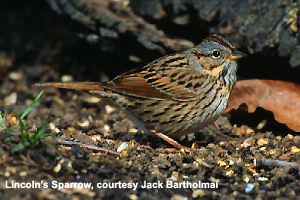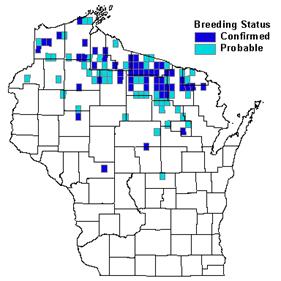

Status/Protection
- Global Rank: G5 Key to global and state ranks
- State Rank: S3B, SZN - see above
- WBCI Priority: None
Population Information
The Federal BBS information can be obtained at http://www.mbr-pwrc.usgs.gov/bbs/bbs.html by clicking on Trend Estimates and selecting the species in question. All estimates are for time period (1966-2005).
- Federal Breeding Bird Survey: significant increase
- Federal Breeding Bird Survey (WI): stable
- Federal Breeding Bird Survey (BCR 23): NA
- Federal Breeding Bird Survey (BCR 12): stable
- WSO Checklist Project: significantly increasing (1983-2007)
Life History
- Breeding Habitat: Open Bog, Jack Pine (regen)
- Nest: in tussock of grass or depression in moss (Ehrlich et al. 1988)
- Nesting Dates: late May – early June (WSO 1995)
- Foraging: ground glean (Ehrlich et al. 1988)
- Migrant Status: Short-distance migrant and Neotropical Migrant, unclear if Wisconsin birds are wintering in the tropics.
- Habitat use during Migration: shrubs, thickets, shrubby riparian areas, suburban parks, gardens, weedy fields (Ammon 1995)
- Arrival Dates: late April – late May (Robbins 1991)
- Departure Dates: early September – late November (Robbins 1991)
- Winter Range: eastern N. American birds winter in TX, south into Central America including Mexico, Costa Rica (DeGraaf and Rappole 1995)
- Winter Habitat: tropical forest both evergreen and deciduous, savannah, coniferous forest, weedy fields and pastures (Ammon 1995)
Habitat Selection
Lincoln’s Sparrow chooses spruce and tamarack bogs, clearcuts near bogs, shrubby willows, or forest openings with dense shrubs. Nests are built on the ground, within grass tussocks or on moss, inside willow shrubs, using sedges and grass stems, willow bark (Ammon 1995). This species most often chooses spruce bog nest sites in northern Wisconsin, while willow shrub nest sites are more common in subalpine and mountain habitats in the western U.S. Ammon (1995) states that LISP is a “microhabitat specialist”, choosing wetter nest site locations than juncos nesting within the same general locations. Muskegs (bogs with scattered small black spruce) are frequently-used nesting choices for LISP in northern WI (Hoffman and Mossman 1993).
Habitat Availability
Lincoln ’s Sparrow is found nesting in Wisconsin in northern swamps and bogs, this habitat type covering an extent of 342,000 hectares (855,000 acres). A typical location with abundant nesting LISP is the Gobler Lake State Natural Area and adjacent muskeg in Oneida County (Hoffman and Mossman 1993). Lincoln’s Sparrow is found in other habitats in Wisconsin during migration, using especially areas of dense shrubs along fencerows, marshes, shrub carr and brushy pastures (Robbins 1991).
Population Concerns
Populations of Lincoln’s Sparrow across its geographic range are increasing slightly (see Population Information, above), with another increase in WI also noted on the Breeding Bird Survey. Robbins et al. (1996) state however that this species is not adequately assessed by the BBS in Wisconsin, (apparently since the habitat preferred by LISP is not often near roads). Some Canadian populations have experienced declines, especially in Quebec, in spruce-hardwood forest (Ammon 1995).
Recommended Management
Howe et al. (1992) list the LISP as an “area-sensitive” species, needing large blocks of habitat for maintaining viable populations. Protection of specific breeding habitat types (especially extensive areas of black spruce muskeg in Wisconsin) is the most effective likely management option for this species.
Research Needs
Much remains to be learned about Lincoln’s Sparrow ecology and biology. Especially needed are studies of reproductive success, physiology during the breeding season and during migration, mating systems, pair formation, the existence of “floater” males with a population, territoriality, and competition with congeneric sparrow species. Population losses in Quebec during the period 1982-1991 may demonstrate the need for protecting large blocks of shrub habitat within spruce-hardwood forest from extensive logging and disturbance – this needs further study (Ammon 1995).
Information Sources
- Wisconsin Breeding Bird Atlas http://www.uwgb.edu/birds/wbba/
- Nicolet NF bird survey map http://www.uwgb.edu/birds/nnf/species/LISP.htm
- Chequamegon NF bird survey map http://oden.nrri.umn.edu/mnbirds/accounts/LISPm2.htm
- NRRI species account http://oden.nrri.umn.edu/mnbirds/accounts/LISPa2.htm
References
- Ammon, E. M. 1995. Lincoln’s Sparrow (Melospiza lincolnii). In The Birds of North America, No. 191 (A. Poole and F. Gill, eds.). The Academy of Natural Sciences, Philadelphia, and The American Ornithologists’ Union, Washington, D.C.
- DeGraaf, R.M., and J.H. Rappole. 1995. Neotropical migratory birds: natural history, distribution, and population change. Comstock Publ. Assoc., Cornell Univ. Press, Ithaca, NY.
- Ehrlich, P.R., D.S. Dobkin, and D. Wheye. 1988.The birders handbook: a field guide to the natural history of North American birds. Simon & Schuster, Inc. New York.
- Hoffman, R.M., and M.J. Mossman. 1993. Birds of Wisconsin’s northern swamps and bogs. Pass. Pigeon 55(2): 113-137.
- Howe, R.W., M.J. Mossman, and S.A. Temple. 1992. Effects of natural forest management on birds in northern Wisconsin. Pass. Pigeon 54 (4) 297-306.
- Robbins, S. D. 1991. Wisconsin birdlife: population & distribution, past & present. Univ. of Wisconsin Press, Madison, WI.
- Robbins. S.D., D.W. Sample, P.W. Rasmussen, and M. J. Mossman. 1996. The breeding bird survey in Wisconsin: 1966-1991. Pass. Pigeon 58(2): 81-180.
- Temple, S.A., J.R. Cary, and R.Rolley. 1997. Wisconsin birds: a seasonal and geographical guide. Second edition. Univ. of Wisconsin Press, Madison, WI.
- Wisconsin Society for Ornithology. 1995. Wisconsin breeding bird atlas; atlasing handbook 1995-1999. Wisconsin Society for Ornithology, Inc., Hartland, WI.
Contact Information
- Compiler: William P. Mueller, iltlawas@earthlink.net
- Editor: Ron Eckstein, Ronald.Eckstein@Wisconsin.gov
